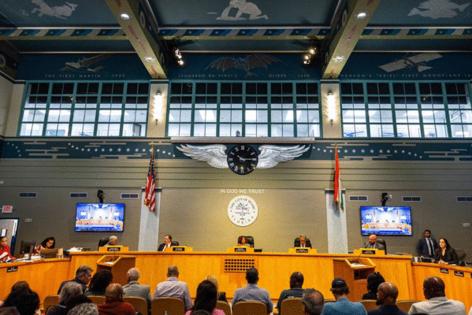More Democrats here, more Republicans there: How Miami's voting districts are changing
Published in News & Features
MIAMI — A proposed new voting map that will go before the Miami City Commission on Thursday as part of a settlement in a racial gerrymandering case makes minor changes to demographics and political affiliations in districts for the city’s five nonpartisan seats, drawing one commissioner out of his district and affirming the residency of another commissioner whose home was cut out during the last election cycle, sparking litigation and accusations of political antics.
The new map was agreed upon as part of a proposed settlement in a federal lawsuit against the city filed by voting rights activists represented by the American Civil Liberties Union. The settlement would mark the end of a contentious legal battle, while costing the city over $1.5 million in attorneys’ fees racked up by the plaintiffs. It also closely coincides with last month’s ouster of City Attorney Victoria Méndez, who had defended the previous map. With the exception of Carollo, commissioners indicated to the Miami Herald that they plan to vote to approve the settlement and the new map.
Last month, U.S. District Judge K. Michael Moore ruled that Miami’s voting map was racially gerrymandered and ordered the city to toss it out. Before the ruling, commissioners had openly stated that the voting map was drawn to ensure the five-member commission comprised three Hispanic, one white and one Black commissioner to guarantee racial diversity of the board’s membership — a policy that Moore said violated the 14th Amendment of the U.S. Constitution.
At first blush, the new map appears to closely resemble the previous version. But Nicholas Warren, an attorney for the ACLU, said the new district lines “follow major roads and easily recognizable boundaries, rather than dividing communities and forming irregular appendages.”
For example, U.S. 1 now separates District 2 from Districts 3 and 4 completely, whereas previous versions had portions of the boundary dipping into Coconut Grove, dividing East and West Grove into separate districts. The new map also uses the Miami River as a boundary between Districts 1, 3 and 5, unifying the Overtown neighborhood.
Commission Chairwoman Christine King celebrated the unification of Overtown, saying residents “will not be negatively impacted by the redistricting.”
“The Overtown community has suffered enough,” King said in an email. “Hopefully, the proposed settlement will resolve the dispute, once and for all. We must move on from this litigation and continue our focus on serving constituents, as this has always been my top priority.”
But not all neighborhoods are in the same district under the proposed new map. By using 22nd Avenue from Northwest Seventh Street to Coral Way as a boundary, the settlement map pushes more of the Little Havana neighborhood into District 4.
Residents in the Shenandoah area were disappointed to learn their neighborhood — which had been split between Districts 3 and 4 — will remain divided, this time with a larger portion in District 3.
“We were really hoping for unification of our neighborhood under one district,” said Lindsay Corrales of the Shenandoah Homeowners Association.
...continued
©2024 Miami Herald. Visit at miamiherald.com. Distributed by Tribune Content Agency, LLC.







Comments